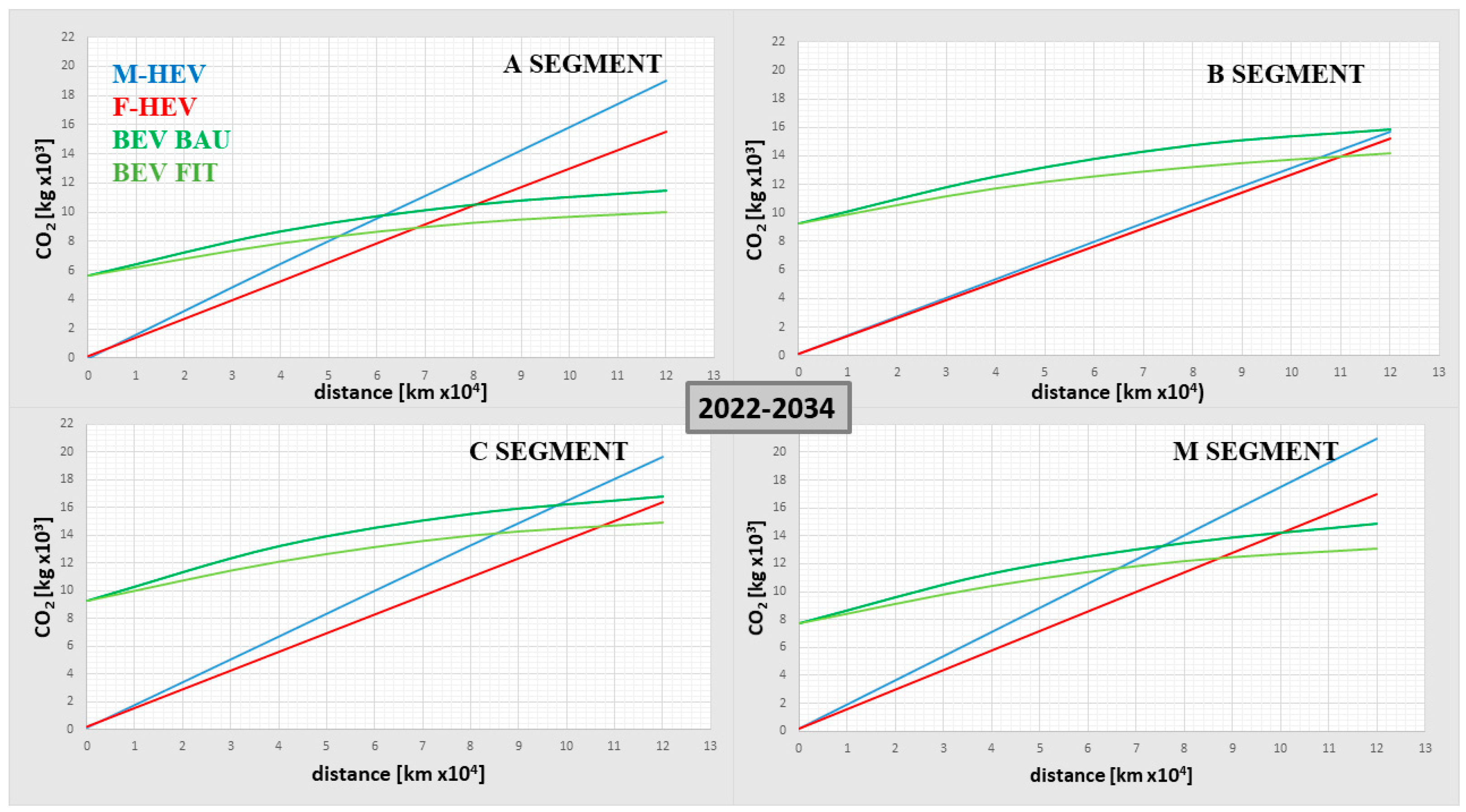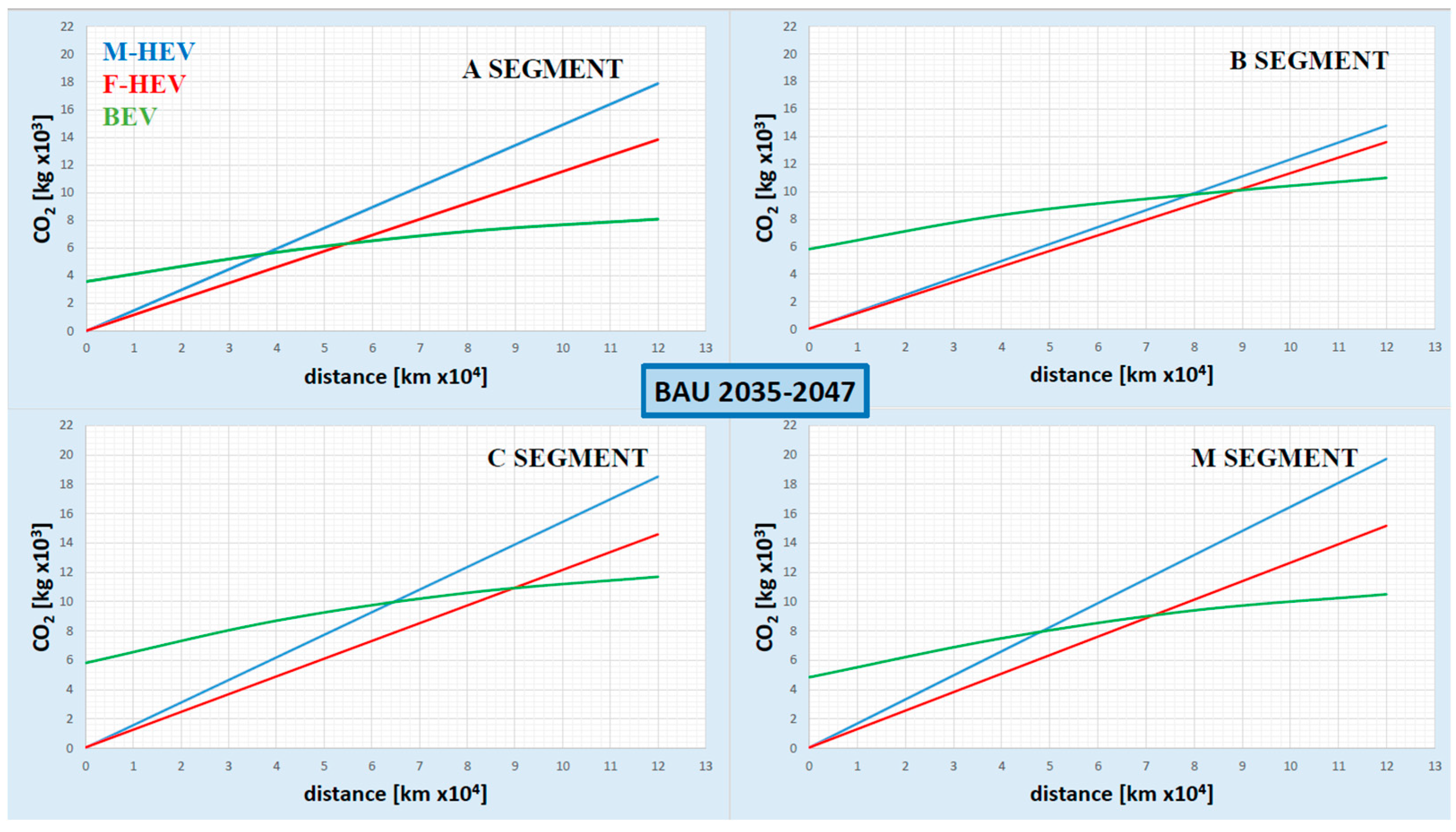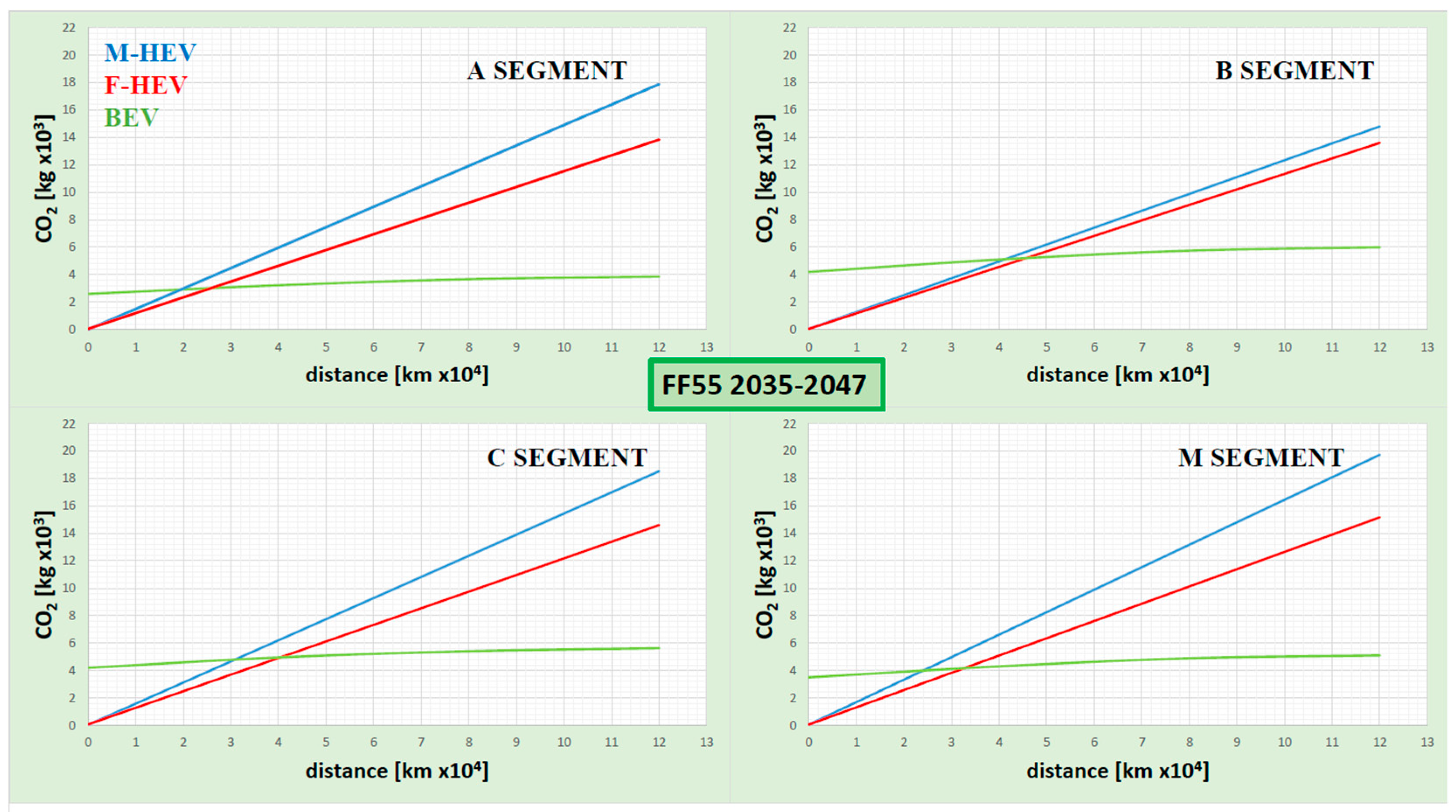The Effectiveness of HEVs Phase-Out by 2035 in Favor of BEVs with Respect to the Production of CO2 Emissions: The Italian Case
Abstract
1. Introduction
2. Materials and Methods
2.1. The Use-Phase Emissions of the Vehicle
- The BAU@2035: is a conservative scenario, i.e., Business-As-Usual. It was constructed considering a consolidated average growth rate (CAGR) of newly installed RES capacity over the period 2016–2021, which was afterward extended until obtaining a certain value of RES in 2035;
- The FF55@2035: is a more aggressive and binding scenario. It was constructed by taking into account the same growth rate of newly installed RES capacity as stated to fulfill the Fit for 55 package objectives by 2030, but extended until obtaining a certain value of RES in 2035
2.2. The Vehicle Production Phase Emissions
3. Results
3.1. The Italian c.i. at 2022
- The primary fuel used and the thermodynamic cycle allowable by the fuel.
- The contribution of RES, whose total incidence varies according to the season and to the different weather conditions.
- The net energy flux imported and exported through the international exchange.
3.2. The Italian c.i. at 2035
3.3. The Carbon Footprint Related to the Battery Production (c.i.b)
3.4. The c.i. of the Vehicles’ Use-Phase
4. Discussion
5. Conclusions
Author Contributions
Funding
Data Availability Statement
Acknowledgments
Conflicts of Interest
References
- Abdul-Manan, A.F.N.; Zavaleta, V.G.; Agarwal, A.K.; Kalghatgi, G.; Amer, A.A. Electrifying passenger road transport in India requires near-term electricity grid decarbonisation. Nat. Commun. 2022, 13, 2095. [Google Scholar] [CrossRef]
- Eurostat. Shedding Light on Energy; 2023 ed.; Eurostat: Luxembourg, 2023; Available online: https://ec.europa.eu/eurostat/web/interactive-publications/energy-2023 (accessed on 27 October 2023).
- McBain, S.; Teter, J. Tracking Transport 2021; IEA: Paris, France, 2021; Available online: https://www.iea.org/reports/tracking-transport-2021 (accessed on 13 September 2023).
- International Energy Agency (IEA). Data Browser. Available online: https://www.iea.org/countries/italy (accessed on 15 November 2023).
- International Energy Agency (IEA). Clean Energy Innovation; IEA: Paris, France, 2020; Available online: https://www.iea.org/reports/clean-energy-innovation (accessed on 15 October 2023).
- The European Automobile Manufacturers’ Association (ACEA). Vehicles in Use, Europe; ACEA: Brussels, Belgium, 2023; Available online: https://www.acea.auto/publication/report-vehicles-in-use-europe-2023/ (accessed on 4 October 2023).
- Woody, M.; Vaishan, P.; Keoleian, G.A.; De Kleine, R.; Kim, H.C.; Anderson, J.E.; Wallington, T.J. The role of pickup truck electrification in the decarbonisation of light-duty vehicles. Environ. Res. Lett. 2022, 17, 034031. [Google Scholar] [CrossRef]
- The European Automobile Manufacturers’ Association (ACEA). Fuel Types of New Cars: Battery Electric, 9.1.%.; Hybrid, 1.9.6.%.; Petrol. 400% Market Share Full-Year 2021; ACEA: Brussels, Belgium, 2021; Available online: https://www.acea.auto/files/20220202_PRPC-fuel_Q4-2021_FINAL.pdf (accessed on 13 September 2023).
- Xia, X.; Li, P. A review of the Life-cycle Assessment of electric vehicles: Considering the influence of batteries. Sci. Total Environ. 2022, 814, 152870. [Google Scholar] [CrossRef] [PubMed]
- Zeng, D.; Dong, Y.; Cao, H.; Li, Y.; Wang, J.; Li, Z.; Hauschild, M.Z. Are the electric vehicles more sustainable than the conventional ones? Influences of the assumptions and modeling approaches in the case of typical cars in China. Resour. Conserv. Recycl. 2021, 167, 105210. Available online: https://www.sciencedirect.com/science/article/abs/pii/S0921344920305279 (accessed on 30 January 2024). [CrossRef]
- European Commission, Directorate-General for Climate Action; Hill, N.; Amaral, S.; Morgan-Price, S.; Nokes, T.; Bates, J.; Helms, H. Determining the Environmental Impacts of Conventional and Alternatively Fuelled Vehicles through LCA—Final Report, Publications Office of the European Union. 2020. Available online: https://data.europa.eu/doi/10.2834/91418 (accessed on 26 December 2023).
- Moro, A.; Lonza, L. Electricity carbon intensity in European Member States: Impacts on GHG emissions of electric vehicles. Transp. Res. Part D Transp. Environ. 2018, 64, 5–14. [Google Scholar] [CrossRef] [PubMed]
- Albatayneh, A.; Assaf, M.N.; Alterman, D.; Jaradat, M. Comparison of the overall energy efficiency for internal combustion engine vehicles and electric vehicles. Environ. Clim. Technol. 2020, 24, 669–680. Available online: https://sciendo.com/it/article/10.2478/rtuect-2020-0041 (accessed on 27 October 2023). [CrossRef]
- European Council. ‘Fit for 55′: Council Adopts Regulation on CO2 Emissions for New Cars and Vans. Available online: https://www.consilium.europa.eu/it/press/press-releases/2023/03/28/fit-for-55-council-adopts-regulation-on-co2emissions-for-new-cars-and-vans/ (accessed on 12 September 2023).
- European Commission. On the Path to a Climate-Neutral Europe by 2050. Available online: https://commission.europa.eu/strategy-and-policy/priorities-2019-2024/european-green-deal/delivering-european-green-deal_en (accessed on 12 September 2023).
- European Council. Fit for 55. Available online: https://www.consilium.europa.eu/en/policies/green-deal/fit-for-55-the-eu-plan-for-a-green-transition/ (accessed on 1 May 2023).
- European Parliament, Council of the European Union. REGULATION (EU) 2023/1542 of the European Parliament and of the Council of 12 July 2023 Concerning Batteries and Waste Batteries, Amending Directive 2008/98/EC and Regulation (EU) 2019/1020 and Repealing Directive 2006/66/EC. Off. J. Eur. Union 2023, 66. Available online: http://data.europa.eu/eli/reg/2023/1542/oj (accessed on 1 December 2023).
- European Commission. Biofuels. Available online: https://energy.ec.europa.eu/topics/renewable-energy/bioenergy/biofuels_en (accessed on 3 January 2024).
- Gustafsson, M.; Svensson, N.; Eklund, M.; Möller, B.F. Well-to-wheel climate performance of gas and electric vehicles in Europe. Transp. Res. Part D Transp. Environ. 2021, 97, 102911. [Google Scholar] [CrossRef]
- Efuel Alliance. What Are Efuels. Available online: https://www.efuel-alliance.eu/efuels/what-are-efuels (accessed on 15 September 2023).
- European Commission. Renewable Energy—Recast to 2030 (RED II). Available online: https://joint-research-centre.ec.europa.eu/welcome-jec-website/reference-regulatory-framework/renewable-energy-recast-2030-red-ii_en (accessed on 15 September 2023).
- European Parliament. Legislative Train Schedule. Revision of the Renewable Energy Directive. In “A European Green Deal”. Available online: https://www.europarl.europa.eu/legislative-train/package-fit-for-55/file-revision-of-the-renewable-energy-directive (accessed on 27 December 2023).
- Cox, B.; Bauer, C.; Beltran, A.M.; van Vuuren, D.P.; Mutel, C.L. Life cycle environmental and cost comparison of current and future passenger cars under different energy scenarios. Appl. Energy 2020, 269, 115021. [Google Scholar] [CrossRef]
- Helmers, E.; Johannes, D.; Weiss, M. Sensitivity Analysis in the Life-Cycle Assessment of Electric vs. Combustion Engine Cars under Approximate Real-World Conditions. Sustainability 2020, 12, 1241. [Google Scholar] [CrossRef]
- Evrard, E.; Davis, J.; Hagdahl, K.-H.; Palm, R.; Lindholm, J.; Dahllöf, L. Carbon Footprint Report—Volvo C40 Recharge; Volvo: Goteborg, Sweden, 2021; Available online: https://www.volvocars.com/us/news/sustainability/Wanted-clean-energy-for-full-climate-benefits/ (accessed on 15 August 2023).
- Petrauskienė, K.; Galinis, A.; Kliaugaitė, D.; Dvarionienė, J. Comparative environmental life cycle and cost assessment of electric, hybrid, and conventional vehicles in Lithuania. Sustainability 2021, 13, 957. [Google Scholar] [CrossRef]
- Onat, N.C.; Kucukvar, M.; Tatari, O. Conventional, hybrid, plug-in hybrid or electric vehicles? State-based comparative carbon and energy footprint analysis in the United States. Appl. Energy 2015, 150, 36–49. Available online: https://www.sciencedirect.com/science/article/abs/pii/S0306261915004407 (accessed on 15 December 2023). [CrossRef]
- Schuller, A.; Stuart, C. From Cradle to Grave: E-Mobility and the Energy Transition. From Cradle to Grave: E-Mobility and the Energy Transition. 2018. Available online: https://europeanclimate.org/wp-content/uploads/2018/09/From-cradle-to-grave-e-mobility-and-the-energy-transition_IT_SP_UK_EU.pdf (accessed on 31 December 2023).
- Pipitone, E.; Caltabellotta, S.; Occhipinti, L. A life cycle environmental impact comparison between traditional, hybrid, and electric vehicles in the European context. Sustainability 2021, 13, 10992. [Google Scholar] [CrossRef]
- Emilsson, E.; Dahllof, L. Lithium-Ion Vehicle Battery Production, Status 2019 on Energy Use, CO2 Emissions, Use of Metals, Products Environmental Footprint, and Recycling; IVL: Stockholm, Sweden, 2019; Available online: https://www.ivl.se/download/18.14d7b12e16e3c5c36271070/1574923989017/C444.pdf (accessed on 8 September 2023).
- Northvolt. Sustainability and Annual Report, 2022; Northvolt: Stockholm, Sweden, 2023; Available online: https://northvolt.com/environment/report2022/ (accessed on 1 November 2023).
- UNRAE. Per Quattroruote L’automobile: Italiani a Confronto; UNRAE: Roma, Italy, 2022; Available online: https://unrae.it/files/Studio%20UNRAE%20L_automobile%20Italiani%20a%20confronto_6336ab4170253.pdf (accessed on 15 October 2023).
- Islam, E.; Vijayagopal, R.; Moawad, A.; Kim, N.; Dupont, B.; Prada, D.N.; Rousseau, A. A Detailed Vehicle Modeling & Simulation Study Quantifying Energy Consumption and Cost Reduction of Advanced Vehicle Technology through 2050; Argonne National Lab (ANL): Argonne, IL, USA, 2021. [CrossRef]
- Capaldi, P.; Grimaldi, F.M. The effectiveness of ICEV phase-out at 2035 in terms of CO2 emission reduction in the Italian scenario. In Proceedings of the 6th International Conference on Energy Harvesting, Storage, and Transfer (EHST’22), Niagara Falls, ON, Canada, 8–10 June 2022; Available online: https://avestia.com/EHST2022_Proceedings/files/paper/EHST_146.pdf (accessed on 27 October 2023).
- Life Cycle Greenhouse Gas Emissions from Electricity Generation: Update. Available online: https://www.nrel.gov/docs/fy21osti/80580.pdf (accessed on 10 October 2023).
- Ministero della Transizione Ecologica—Dip.Energia—Direzione Generale Infrastrutture e Sicurezza. La Situazione Energetica Nazionale Nel 2021. Italy. Available online: https://dgsaie.mise.gov.it/pub/sen/relazioni/relazione_annuale_situazione_energya_nazionale_dati_2021.pdf (accessed on 27 September 2023).
- ANIE Federazione. Sala Stampa—Comunicati Stampa. Osservatorio FER. Available online: https://anie.it/sala-stampa/comunicati-stampa/ (accessed on 10 October 2023).
- International Energy Agency (IEA). Italy 2023—Energy Policy Review; IEA: Paris, France, 2023; Available online: https://www.iea.org/reports/italy-2023 (accessed on 27 October 2023).
- Terna—Snam. Documento di Descrizione Degli Scenari 2022; Terna/Snam: Roma, Italy, 2022; Available online: https://www.terna.it/it/sistema-elettrico/rete/piano-sviluppo-rete/scenari (accessed on 10 October 2023).
- EMBER European Union. The EU Accelerates Electricity Transition in the Wake of Crisis. Explore Open Data (Emissions Intensity). Available online: https://ember-climate.org/countries-and-regions/regions/european-union/ (accessed on 2 October 2023).
- Terna. Evoluzione Rinnovabile 2021; Terna: Roma, Italy, 2021; Available online: https://download.terna.it/terna/Evoluzione_Rinnovabile_8d940b10dc3be39.pdf (accessed on 27 October 2023).
- Teske, S.; Morris, T.; Nagrath, K. 100% Renewable Energy: An Energy [R] Evolution for ITALY. Report Prepared by ISF for Greenpeace Italy. 2020. Available online: https://www.uts.edu.au/sites/default/files/article/downloads/100-Percent-Renewable-Energy-Italy-report.pdf (accessed on 1 May 2023).
- International Energy Agency (IEA). Electricity Grids Secure Energy Transition; IEA: Paris, France, 2023; Available online: https://www.iea.org/reports/electricity-grids-and-secure-energy-transitions (accessed on 21 October 2023).
- International Energy Agency (IEA). Electricity 2024, Analysis and Forecast to 2026; IEA: Paris, France, 2024; Available online: https://www.iea.org/reports/electricity-2024 (accessed on 24 January 2024).
- The International EPD System Documentation Overview for, Environmental Product Declaration; PCR. Available online: https://environdec.com/resources/documentation#generalprogrammeinstructions (accessed on 1 November 2023).
- Link, S.; Neef, C.; Wicke, T. Trends in Automotive Battery Cell Design: A Statistical Analysis of Empirical Data. Batteries 2023, 9, 261. [Google Scholar] [CrossRef]
- Maus, V.; Werner, T.T. Impacts for half of the world’s mining areas are undocumented. Nature 2024, 625, 26–29. [Google Scholar] [CrossRef] [PubMed]
- Spritmonitor.de. MPG and Cost Calculator and Tracker. Available online: https://www.spritmonitor.de/en/ (accessed on 21 October 2023).
- ADAC. Elektroautos im Test: So Hoch ist die Reichweite Wirklich. Available online: https://www.adac.de/rund-ums-fahrzeug/elektromobilitaet/tests/stromverbrauch-elektroautos-adac-test/ (accessed on 10 October 2023).
- Edwards, R.; Larivé, J.-F.; Rickeard, D.; Weindorf, W. JEC, Well-to-Wheels Analysis, Well-to-Wheels Analysis of Future Automotive Fuels and Powertrains in the European Context”, Concawe-EUCAR-JRC; JRC: Bruxelles, Belgium, 2014; Available online: https://publications.jrc.ec.europa.eu/repository/bitstream/JRC85326/wtt_report_v4a_april2014_pubsy.pdf (accessed on 10 September 2023).
- Argonne National Laboratory. Energy Systems and Infrastructure Analysis, GREET Model—The Greenhouse Gases, Regulated Emissions, and Energy Use in Technologies Model. Available online: https://greet.es.anl.gov/ (accessed on 1 October 2023).
- Reick, B.; Konzept, A.; Kaufmann, A.; Stetter, R.; Engelmann, D. Influence of charging losses on energy consumption and CO2 emissions of battery-electric vehicles. Vehicles 2021, 3, 736–748. [Google Scholar] [CrossRef]
- Genovese, A.; Ortenzi, F.; Villante, C. On the energy efficiency of quick DC vehicle battery charging. World Electr. Veh. J. 2015, 7, 570–576. [Google Scholar] [CrossRef]
- Goto, T.; Isobe, R.; Yamakawa, M.; Nishida, M. The New Mazda Gasoline Engine Skyactiv-G. MTZ Worldw. eMag. 2011, 72, 40–47. [Google Scholar] [CrossRef]
- EMBER Italy. Fossil Gas still Dominates Italy’s Electricity but Renewable Power Targets Have Increased. Available online: https://ember-climate.org/countries-and-regions/countries/italy/ (accessed on 24 November 2023).
- EMBER Europe. Uneven Progress Towards Clean Electricity. Available online: https://ember-climate.org/countries-and-regions/regions/europe/ (accessed on 17 December 2023).
- SNAM; The European House-Ambrosetti. H2 Italy 2050. A National Hydrogen Value Chain for the Growth and Decarbonization of Italy; SNAM, The European House-Ambrosetti: Milano, Italy, 2020; Available online: https://www.ambrosetti.eu/en/community-innotech/hydrogen-community/ (accessed on 30 September 2023).



| Car Segment | Powertrain | ||
|---|---|---|---|
| M-HEV | F-HEV | BEV | |
| A 1 | Suzuki Ignis | Honda Jazz | VW UP |
| B 2 | Mazda 2 | Toyota Yaris | Nissan Leaf |
| C 3 | Ford Focus | Hyundai Ioniq | Tesla Mod.3 |
| M 4 | Suzuki Vitara | VW Tiguan | Opel Mokka |
| NG (TWh) | OTHER NON- RES (TWh) | HYDRO (TWh) | PV (TWh) | WIND (TWh) | OTHER RES (TWh) | CURTAILMENT/ STORAGE LOSSES (TWh) | Net I/E (TWh) | c.i.e. (gCO2/kWh) | |
|---|---|---|---|---|---|---|---|---|---|
| 2022 | 140 | 22 | 47 | 25 | 21 | 23 | −1 | 43 | 293 |
| 2035 BAU | 155 | 7 | 51 | 35 | 30 | 23 | −4 | 53 | 249 |
| 2035 FF55 | 57 | 3 | 51 | 136 | 90 | 23 | −26 | 53 | 110 |
| Energy Scenario | Electric C.I. (p.p.) 1 (kgCO2/kWh) | Electric C.I. (m.v.) 2 (kgCO2/kWh) | Electric C.I. (l.v.) 3 (Socket c.i.) (kgCO2/kWh) |
|---|---|---|---|
| 2022 | 0.293 | 0.308 | 0.318 |
| 2035 BAU | 0.249 | 0.262 | 0.270 |
| 2035 FF55 | 0.110 | 0.116 | 0.120 |
| Authors | CO2 Specific Emissions Related to the Battery Cell (kgCO2/kWh) | CO2e Emissions Related to Mining and Refining Processes (kgCO2/kWh) | CO2e Emissions from Scrap Materials (kgCO2/kWh) |
|---|---|---|---|
| Cox et al. (2017) [22] | 100 | N.C. 1 | N.C. |
| IVL (2019) [30] | 80 | N.C. | N.C. |
| Helmers et al. (2020) [23] | 90 | N.C. | N.C. |
| Woody et al. (2021) [7] | 90 | N.C. | N.C. |
| Volvo 2 (2021) [24] | 90 | 50 | 15 |
| Northvolt (2022) [31] | 130 3 | // | // |
| Energy Scenario | Electric C.I. (Battery Production Plant) (kgCO2/kWh) | (a) CO2 for Mining and Refining (kgCO2/kWh) | (b) CO2 for Battery Cell Production (kgCO2/kWh) | (c) CO2 for Scrap Materials Production (kgCO2/kWh) | (d) CO2 for Battery Pack Assembly (kgCO2/kWh) | (e) Total CO2 for Battery Pack Production (kgCO2/kWh) | (f) Total CO2 for Enhanced Battery @2035 (+20% Energy) (kgCO2/kWh) |
|---|---|---|---|---|---|---|---|
| 2022 | 0.308 | 45 | 74 | 15 | 20 | 154 | // |
| 2035 BAU | 0.262 | 40 | 50 | 14 | 18 | 122 | 97 |
| 2035 FF55 | 0.116 | 40 | 23 | 10 | 14 | 87 | 70 |
| Energy Scenario | C.I.E. @Socket | AC Charging Phase Efficiency | C.I.C. @Vehicle Battery (PTB) |
|---|---|---|---|
| 2022 | 0.318 | 0.85 | 0.374 |
| BAU@2035 | 0.270 | 0.88 | 0.307 |
| FF55@2035 | 0.120 | 0.88 | 0.137 |
| Mild HEV Car Segment | Model | Fuel Consumption (dm3/km) | Battery Capacity (kWh) | CO2 for Battery Production (kgCO2) |
| A | Suzuki Ignis | 0.054 | 0.13 | 20 |
| B | Mazda 2 | 0.046 | 0.90 | 138 |
| C | Ford Focus | 0.058 | 1.20 | 185 |
| M | Suzuki Vitara | 0.062 | 1.10 | 169 |
| Full HEV Car Segment | Model | Fuel Consumption (dm3/km) | Battery Capacity (kWh) | CO2 for Battery Production (kgCO2) |
| A | Honda Jazz | 0.046 | 0.75 | 115 |
| B | Toyota Yaris | 0.045 | 0.90 | 138 |
| C | Hyundai Ioniq | 0.048 | 1.6 | 200 |
| M | VW Tiguan | 0.050 | 1.20 | 185 |
| BEV Car Segment | Model | Energy Consumption (kWh/km) | Battery Capacity (kWh) | Battery Carbon Intensity (kgCO2) |
| A | VW UP | 0.141 | 37 | 5700 |
| B | Nissan Leaf | 0.162 | 60 | 9240 |
| C | Tesla Mod.3 | 0.184 | 60 | 9240 |
| M | Opel Mokka | 0.177 | 50 | 7700 |
| SCENARIO | CAR SEGMENT | POWERTRAIN | ||
|---|---|---|---|---|
| BEV | Full HEV | Mild HEV | ||
| 2022@ BAU | A | Ref. | +35% | +66% |
| B | “ | −4% | −1% | |
| C | “ | −2% | +17% | |
| M | ” | +14% | +40% | |
| 2022@ FF55 | A | “ | +55% | +90% |
| B | “ | +8% | +11% | |
| C | “ | +10% | +32% | |
| M | “ | +29% | +60% | |
| BAU@2035 | A | “ | +71% | +121% |
| B | “ | +23% | +34% | |
| C | “ | +25% | +58% | |
| M | “ | +44% | +88% | |
| FF55@2035 | A | “ | +259% | +364% |
| B | “ | +126% | +147% | |
| C | “ | +160% | +229% | |
| M | “ | +197% | +286% | |
Disclaimer/Publisher’s Note: The statements, opinions and data contained in all publications are solely those of the individual author(s) and contributor(s) and not of MDPI and/or the editor(s). MDPI and/or the editor(s) disclaim responsibility for any injury to people or property resulting from any ideas, methods, instructions or products referred to in the content. |
© 2024 by the authors. Licensee MDPI, Basel, Switzerland. This article is an open access article distributed under the terms and conditions of the Creative Commons Attribution (CC BY) license (https://creativecommons.org/licenses/by/4.0/).
Share and Cite
Grimaldi, F.M.; Capaldi, P. The Effectiveness of HEVs Phase-Out by 2035 in Favor of BEVs with Respect to the Production of CO2 Emissions: The Italian Case. Energies 2024, 17, 961. https://doi.org/10.3390/en17040961
Grimaldi FM, Capaldi P. The Effectiveness of HEVs Phase-Out by 2035 in Favor of BEVs with Respect to the Production of CO2 Emissions: The Italian Case. Energies. 2024; 17(4):961. https://doi.org/10.3390/en17040961
Chicago/Turabian StyleGrimaldi, Francesca Maria, and Pietro Capaldi. 2024. "The Effectiveness of HEVs Phase-Out by 2035 in Favor of BEVs with Respect to the Production of CO2 Emissions: The Italian Case" Energies 17, no. 4: 961. https://doi.org/10.3390/en17040961
APA StyleGrimaldi, F. M., & Capaldi, P. (2024). The Effectiveness of HEVs Phase-Out by 2035 in Favor of BEVs with Respect to the Production of CO2 Emissions: The Italian Case. Energies, 17(4), 961. https://doi.org/10.3390/en17040961







